Thursday, 16 June 2011: Vienne in the sun and the rain
Written 7 July 2011
The breakfast buffets on this trip have been pretty standard, but the one in Vienne had one notable innovation—two tall, sinuous wire dispensers, sort of like those you can get for your fridge that load from the top and dispense canned beverages one at a time at the bottom, only these were built to hold spheres rather than cylinders. One was loaded with apples and the other with oranges! But we partook of neither, sticking with our usual bread and butter, coffee or chocolate, croissant or pain au chocolat.
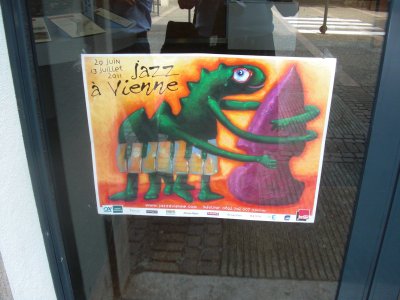
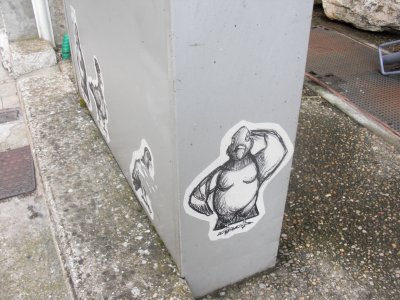 After breakfast, the first order of business was to go back to the Office de Tourisme for audioguides and do the city walking tour. With or without guides, though, the first thing you see in Vienne is the "Jazz à Vienne" poster. Here, on the left, is the full version, but myriad versions of it, showing all or only various parts of the image (in some, the creature grins toothily), are plastered on every available display surface and shop window not just in Vienne but all up and down the valleys of the Saône and Rhône as far as we traveled in any direction. I take the green creature to be a lizard of some kind, although it has an awful lot of legs for a reptile (as well as a sort of skirt of piano keys). The purple object must be the famous Vienne pyramid (photo of the real one below). Anyway, the Vienne Jazz Festival is a very, very big deal, and we got out of the area just in time—it was due to begin on 29 June and run for two weeks.
After breakfast, the first order of business was to go back to the Office de Tourisme for audioguides and do the city walking tour. With or without guides, though, the first thing you see in Vienne is the "Jazz à Vienne" poster. Here, on the left, is the full version, but myriad versions of it, showing all or only various parts of the image (in some, the creature grins toothily), are plastered on every available display surface and shop window not just in Vienne but all up and down the valleys of the Saône and Rhône as far as we traveled in any direction. I take the green creature to be a lizard of some kind, although it has an awful lot of legs for a reptile (as well as a sort of skirt of piano keys). The purple object must be the famous Vienne pyramid (photo of the real one below). Anyway, the Vienne Jazz Festival is a very, very big deal, and we got out of the area just in time—it was due to begin on 29 June and run for two weeks.
The second thing you see is the anthropomorphic pigeons, favorite subject of the most active local graffitist, which were everywhere (but only in Vienne as far as I could tell). This group was at about knee height near the Roman theater.
What the audioguide wants you to see though, and to tell you about (as you follow its exceptionally well marked trail of little brass images of a tree, set in the sidewalk), is (1) churches, (2) Roman antiquities, and (3) other history. They have a lot of all three. We visited the Old St. Maurice Cathedral, St. Pierre's church, and St. André le Bas and admired from afar St. André le Haut and the church up on Mount Pipet. In St. Maurice, some of the side chapels retain much more of the original polychrome decor than usually survives. These old churches must really have been spectacular in the days when they were first completed and decorated.
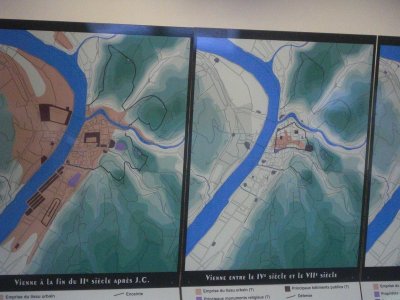
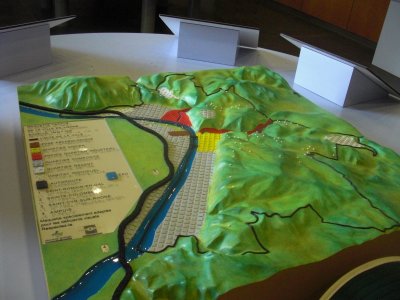 One of the stops on the tour was the Salle du Patrimoine (the Hall of Patrimony), a free one-room museum dedicated to the urban development of Vienne from its founding (ca. 100 B.C.) to the present. It featured a lot of excellent models and maps illustrating the various stages of the city's expansion and, sometimes, contraction. On the left are two maps: the city in the 2nd century A.D. (left) and another of the same area between the 4th and 7th centuries (right), when it had gotten much smaller. The most amazing feature of the 2nd-century map is the city wall, which is the long sinuous black line surrounding the settled area on the east bank of the river. I had been puzzled to learn that the Roman forum (the largest black rectangle on the east bank) was built right down on the river, surrounded by four tall hills. That seemed very un-Roman—didn't they always settle on hilltops, for defensive purposes if nothing else? But that map of the city wall explained all. The river bank was convenient—those long black rectangles south of the city center were a major freight depot—but they couldn't risk an enemy's attacking from the higher ground, so they just ran the city wall out through what must have been open countryside at the time, in that odd, four-lobed pattern, to fence in all four hill-tops!
One of the stops on the tour was the Salle du Patrimoine (the Hall of Patrimony), a free one-room museum dedicated to the urban development of Vienne from its founding (ca. 100 B.C.) to the present. It featured a lot of excellent models and maps illustrating the various stages of the city's expansion and, sometimes, contraction. On the left are two maps: the city in the 2nd century A.D. (left) and another of the same area between the 4th and 7th centuries (right), when it had gotten much smaller. The most amazing feature of the 2nd-century map is the city wall, which is the long sinuous black line surrounding the settled area on the east bank of the river. I had been puzzled to learn that the Roman forum (the largest black rectangle on the east bank) was built right down on the river, surrounded by four tall hills. That seemed very un-Roman—didn't they always settle on hilltops, for defensive purposes if nothing else? But that map of the city wall explained all. The river bank was convenient—those long black rectangles south of the city center were a major freight depot—but they couldn't risk an enemy's attacking from the higher ground, so they just ran the city wall out through what must have been open countryside at the time, in that odd, four-lobed pattern, to fence in all four hill-tops!
The half-circle to the right of the forum is the theater. Note also the long open rectangle south of town. That was the circus, and its location is not speculative. The decorative pyramid that graced its infield is still standing and has become the primary symbol of the city.
The primarily green relief map at the right is a terrific idea. It's designed for the blind. Each zone of the city is laid out in a different texture—convex and concave squares, rough and smooth, all labeled at the left-hand edge in Braille!
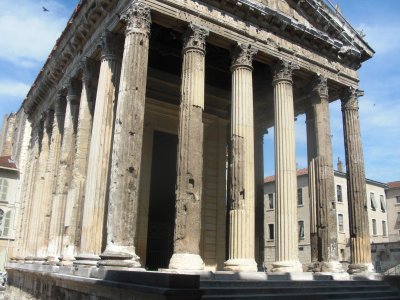
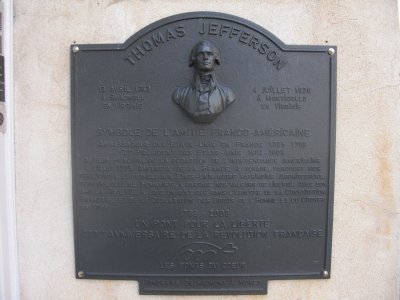 Some of the Roman buildings in Vienne are spectacularly well preserved. Perhaps the most striking is the "Temple d'Auguste et de Livie" (left) which was the focal point of the Roman forum and is now right in the middle of the town. I had to frame the photo very tightly to keep the café umbrellas out of the shot! It hasn't always been valued as it is today—at various times in its history, the spaces between its colums were bricked up so that it could serve as, e.g., a public library or office space.
Some of the Roman buildings in Vienne are spectacularly well preserved. Perhaps the most striking is the "Temple d'Auguste et de Livie" (left) which was the focal point of the Roman forum and is now right in the middle of the town. I had to frame the photo very tightly to keep the café umbrellas out of the shot! It hasn't always been valued as it is today—at various times in its history, the spaces between its colums were bricked up so that it could serve as, e.g., a public library or office space.
Nearby is this large plaque honoring Thomas Jefferson and thanking him for help with the drafting of the French constitution.
As the tour took us past St. André le Bas, whom should we encounter (in addition to the little white tourist train, which passed us at that point) but the cat—the one we had noticed in that neighborhood the evening before, headed somewhere purposefully and then headed back the other way later. We made friendly overtures, and it came right up to have its ears scratched. It was, though, perhaps the dirtiest cat we ever encountered—not visibly dirty, but sticky and gritty to the touch!
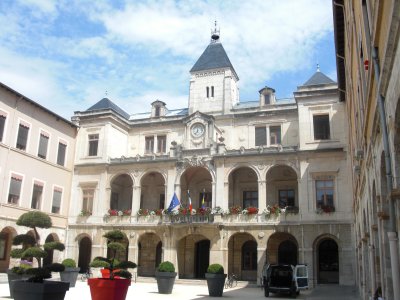
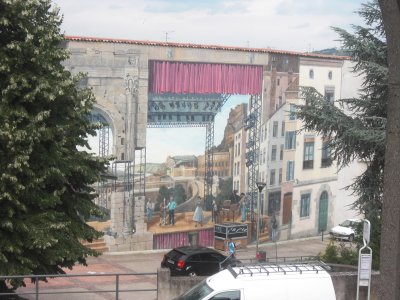 Another major feature of Vienne is its Roman theater, which, unlike most we've seen, is still actually in use. We couldn't really see much of it because it was to be the major venue for the upcoming jazz festival, so it was heavily girded with construction fence, and a huge stage was being erected. Way up the hill above and behind it, though, we could see the Belvedere of the Pipet, crowned with a church (St. Marcel, maybe?) and a giant statue of the virgin Mary.
Another major feature of Vienne is its Roman theater, which, unlike most we've seen, is still actually in use. We couldn't really see much of it because it was to be the major venue for the upcoming jazz festival, so it was heavily girded with construction fence, and a huge stage was being erected. Way up the hill above and behind it, though, we could see the Belvedere of the Pipet, crowned with a church (St. Marcel, maybe?) and a giant statue of the virgin Mary.
Then, on the way back down the hill into the middle of town, we came upon this marvelous mural of a theatrical production being mounted. It happened to be a day on which the real sky (visible at the top, above the thin horizontal line of tiles) and the sky in the mural matched almost perfectly, so the illusion was amazing. The cars and the trees are real; the right-most door and window and the windows above them might be, though I'm not sure. The rest is painted on a flat surface.
Beyond the building with the mural on the back is a small sunken garden, covered, at the time, with a temporary stage a propos of the jazz festival (built around a few trees, which protruded up through it), the city's "ordinary theater" in the form of an 18th or 19th century building, and the Museum of Beaux-Arts and Archeology, none of which we had time to visit. The last stop on the tour before it took us back past our hotel was the town hall, shown at the right above. The audioguide said to step inside to admire the grand staircase, so I did, but no staircase was evident, so I must have been at the wrong door.
The tour included a ton of other stuff—medieval hobnailed doors, the fabric museum, sundry architectural features—but if I try to describe all of it, I'll never finish! Good tour, though, and for once we walked the entire route.
Since our hotel was on the way to back to the Office de Tourisme, where we had to turn in our audioguides, we stopped in to get our raincoats, because the weather was begibing to look threatening. The forecast had said it might rain, but its recent predictions had borne no discernible relation to the actual weather we experienced, so most days we just relied on squinting at the sky. The plan was to get lunch in the vicinity of the hotel, where we'd spotted a nice cluster of restaurants, then to continue on to the Office de Tourisme to turn in the guides, then to go on beyond that, up the quai, over the bridge, and to the Gallo-Roman museum of Saint-Romain-en-Gal, which was just at the bridge's other end.
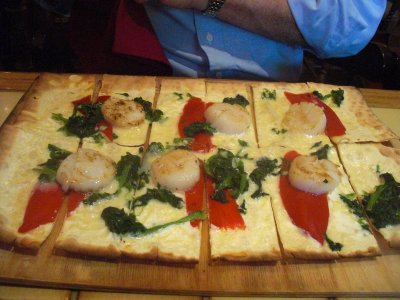
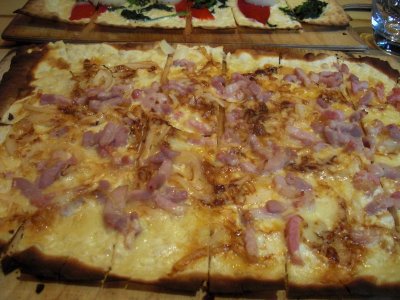 The very first restaurant we passed was the Tavern du Maître Kanter, an Alsatian themed chain that you encounter all over France. David had mentioned that he was hungry for a beef tartare, which they had, and I was seduced by the prospect of a flammekuche, which I love. Once inside, though, David postponed his beef, which is easy to come by in France, to go for a scallop-spinach-and-red-bell-pepper flammekuche, which you can't get just anywhere. I had the house flammekuche, with onions, lardons, cheese, and cream. Both were excellent, but I didn't think the scallops were really in keeping with the spirit of the dish.
The very first restaurant we passed was the Tavern du Maître Kanter, an Alsatian themed chain that you encounter all over France. David had mentioned that he was hungry for a beef tartare, which they had, and I was seduced by the prospect of a flammekuche, which I love. Once inside, though, David postponed his beef, which is easy to come by in France, to go for a scallop-spinach-and-red-bell-pepper flammekuche, which you can't get just anywhere. I had the house flammekuche, with onions, lardons, cheese, and cream. Both were excellent, but I didn't think the scallops were really in keeping with the spirit of the dish.
As we ate, the thunder abruptly crashed and the rain began, torrentially. We decided to wait the worst of it out and then try to hail a cab from the stand across the street (outside the train station) without leaving the shelter of the Maître Kanter's doorway, but the rain didn't let up for quite a while, and the cab stand, which had been occupied by at least three cabs at all times for the last hour, was suddenly deserted. I really wanted to see the museum, but David really didn't want to walk there in the rain—he worries much more than I do about getting his shoes soaking wet. So we scurried back around the corner to the hotel and asked the desk clerk to telephone for a taxi. First he had trouble even getting them to answer, then all they could say was, "Hopeless; call back in 20 minutes." At this point, I was beginning to worry about missing the only-once-a-day guide tour, even if we could get to the museum at all! Even fetching our own car would have involved a hike, in the rain, to the garage, dealing with the automated check-out feature, parking at the other end (who knew where?), and walking to the museum, in the rain. The clerk, though, didn't wait the 20 minutes but tried again after five, and this time, voila!, a taxi was at the door in another two minutes!
So we packed up the audioguides, took them with us to the museum, checked them at the entrance with our hats and coats, and
had 15 minutes to look around on our own before reporting to the rendezvoux point. Once again, we were the only takers (June really is the time to visit France), so we had another superdeluxe private guided tour.
A few years ago, the city of Vienne outgrew its high school and set out to build a new one, on a large patch of largely open ground across the bridge from downtown, but the project came to a screeching halt almost as soon as it started when the backhoe bucket came up full of multicolored tesserae. Aargh! We've dug up a mosaic! Experts were called in, set up their echosounding equipment, got very excited, and pointed sternly off into the distance, moving the backhoe and all its friends (and the eventual high school) half a mile farther from the river.
On the choice spot, to the right of the road as you leave the bridge, they instead built the new museum of Gallo-Roman antiquities, up on piles, as it, too, is right on top of prime archeological ground, and set about filling it, from digs just outside. Visit its website, at http://www.musees-gallo-romains.com/st_romain/presentation/index.html for good photos of the building, which is about 80% glass, with enough metal plates and cables to hold it together and give you somewhere to walk.
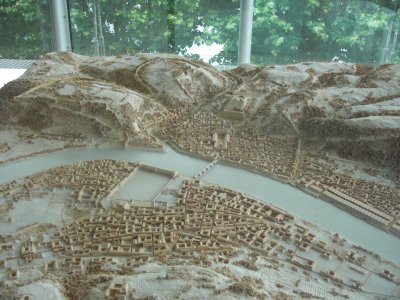
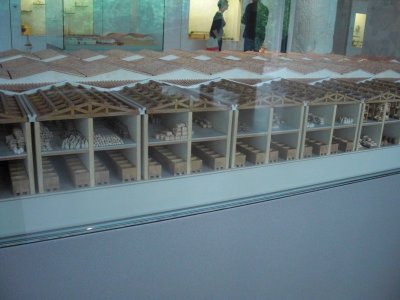 One of the first things you see is this model of the Roman town, viewed here from the west looking east. The forum is the rectangle in the middle of the town, a few blocks inland from the far end of the bridge. The tiny rectangle inside it is the Temple d'Auguste et de Livie, the only part of it still standing. On the hillside behind and a little to the right of it, you can see the flat side of the Roman theater, and above that on the hilltop is the Belvedere of the Pipet, know occupied by a church. The Odeum is a little hard to see, but it's to the right of the theater and at right angles to it, on the adjacent hillside. You can see the city wall loop around the two hilltops to the left of downtown. The other end of it is the heavy, straight line running down to the river, many blocks south of the forum. The circus is out of the photo to the right. Just outside the wall, along the river south of town, are two long lines of warehouses, only part of the huge freight depot that was the town's reason for existence. The photo to the right is of a somewhat speculative cutaway model of those warehouses. Despite the glare on the plexiglas case, you can see, e.g., large wooden bins, bales, and stacked amphorae.
One of the first things you see is this model of the Roman town, viewed here from the west looking east. The forum is the rectangle in the middle of the town, a few blocks inland from the far end of the bridge. The tiny rectangle inside it is the Temple d'Auguste et de Livie, the only part of it still standing. On the hillside behind and a little to the right of it, you can see the flat side of the Roman theater, and above that on the hilltop is the Belvedere of the Pipet, know occupied by a church. The Odeum is a little hard to see, but it's to the right of the theater and at right angles to it, on the adjacent hillside. You can see the city wall loop around the two hilltops to the left of downtown. The other end of it is the heavy, straight line running down to the river, many blocks south of the forum. The circus is out of the photo to the right. Just outside the wall, along the river south of town, are two long lines of warehouses, only part of the huge freight depot that was the town's reason for existence. The photo to the right is of a somewhat speculative cutaway model of those warehouses. Despite the glare on the plexiglas case, you can see, e.g., large wooden bins, bales, and stacked amphorae.
The large open space just to the left of the near end of the bridge is the museum's grounds. Echo sounding has revealed that it is an almost complete residential and commercial neighborhood of the Roman city. The upper parts of the houses are gone, but large parts of their floors, and lower floors are still there but shallowly buried. The area also includes some smaller warehouses and three public baths (one large and two small). The museum is in the early stages of a projected complete excavation of the whole area, including that actually under the museum.
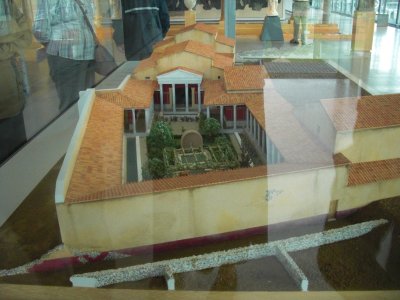
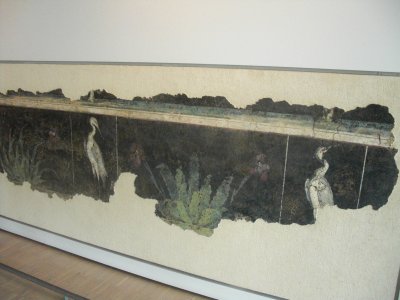 Every Roman house (and Vienne considered itself a Roman city) was almost windowless on the outside. All the rooms faced inward onto one or more open courtyards—atria. Merchants regularly did business out of their houses—less valuable clients would be received in the entrance hall, more important ones "further in," and the most important in the atrium. The model on the left is of one of the largest houses in the neighborhood, already excavated. The atrium was typically planted as a garden, with a pool or fountain if the owner could afford it, and as the fragment at the right shows, the walls were painted with frescoes, usually also depicting nature. The most frequently preserved part of a Roman house is the mosaic floor; very few wall frescoes survive, and the Vienne site is particularly rich in them.
Every Roman house (and Vienne considered itself a Roman city) was almost windowless on the outside. All the rooms faced inward onto one or more open courtyards—atria. Merchants regularly did business out of their houses—less valuable clients would be received in the entrance hall, more important ones "further in," and the most important in the atrium. The model on the left is of one of the largest houses in the neighborhood, already excavated. The atrium was typically planted as a garden, with a pool or fountain if the owner could afford it, and as the fragment at the right shows, the walls were painted with frescoes, usually also depicting nature. The most frequently preserved part of a Roman house is the mosaic floor; very few wall frescoes survive, and the Vienne site is particularly rich in them.
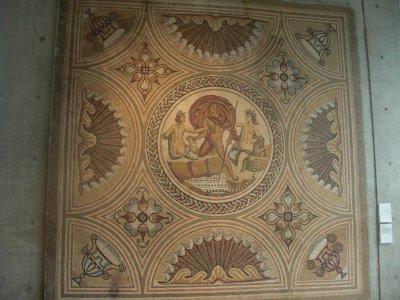
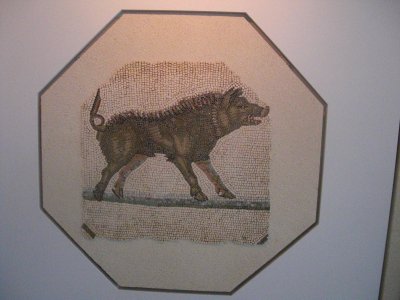 The museum displayed many mosaics, either wall-mounted like these or laid out on the floor, behind velvet ropes, where the curators have reconstructed whole rooms of a house (with furniture but without walls). All but one are in very typically Roman style of the period, whether figurative or geometric—they all looked very much like the ones we saw in Lyon. (A reconstructed dining room and bedroom were furnished with dining couches and beds copied from the one in Lyon—because they were made of wood and leather, only one intact one has ever been found—with turned wooden legs and leather webbing to support the cushions.)
The museum displayed many mosaics, either wall-mounted like these or laid out on the floor, behind velvet ropes, where the curators have reconstructed whole rooms of a house (with furniture but without walls). All but one are in very typically Roman style of the period, whether figurative or geometric—they all looked very much like the ones we saw in Lyon. (A reconstructed dining room and bedroom were furnished with dining couches and beds copied from the one in Lyon—because they were made of wood and leather, only one intact one has ever been found—with turned wooden legs and leather webbing to support the cushions.)
We were even shown the one with two prominent backhoe bites out of it—the very one that led to discovery of the site—as well as some from which the central or other particularly nice parts had been removed long ago, perhaps by the same people who dismantled the upper parts of the houses over the centuries, to reuse the stone. When you think about all those floods in Lyon, immediately upstream, it's not hard to see how the lower parts of the houses got buried and forgotten.
In addition to the mosaics and models, —and one beautiful white marble Venus recovered from the site—the museum presents excellent displays on pottery making, mosaic making, and many other crafts of the time. Vienne had a thriving pottery industry for several hundred years, which then abruptly disappeared—apparently cheap foreign imports drove it out of business.
One thing I had never known before was that all those myriad amphorae shipped around the Roman empire were not reused. Apparently shipping them back for refilling was not economically viable, so unless the household had use for them, they were broken up and used for, e.g., mulch or paving gavel paths. One use to which a certain number were put, though, was in building vapor barriers. Underneath the floor of a new house or other building, a bed of sand was laid, and a close-packed layer of amphorae was stood on it, mouths down and "tails in the air," and the floor was laid over that. This arrangement apparently prevented "rising damp," a particular problem on this very low site near the river. In the discussion of Roman construction methods we learned a terrific new word—pouzzolane. The guide said it was used in cement, but I had left my pocket recorder in the pocket of my raincoat, in the checkroom, so not only could I not remember the whole word later but I had no idea of the spelling—in my notes later, I wrote down "pudza-something." The guide didn't know the English word for it, but from his description—volcanic origin, very light in weight—we though it must be pumice, but my dictionary translated pumice into French as "ponce," so I was at a loss. A couple of weeks later, though, back in Tallahassee, we were reading Jules Verne's L'Isle Mystérieuse, and there it was! Pouzzolane! The French dictionary said it was volcanically produced cinders, very light in weight, mixed with lime to make cement, and named after the Italian city of of Pozzuoli, near Naples. A little poking around in the OED finally yielded the English version, "pozzolana," extremely light volcanic ash containing silica, alumina, etc. One of the example sentences said it consisted of "pyrites, burnt."
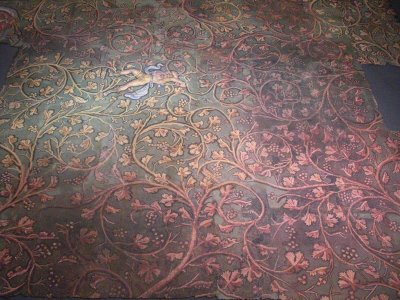
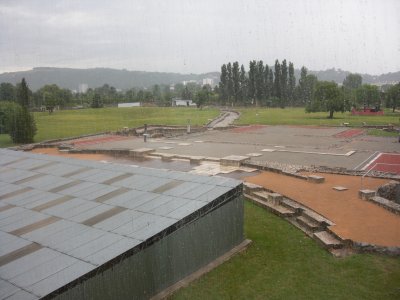 The last item on the tour, in a special room all to itself, was this very large mosaic, of which only part is shown here. The figure in the center is some character from mythology who offended a powerful god and woke up to find himself being entwined and smothered by vines. Here he's shown trying to chop his way free. Some other figures appear nearer the edges, and at the right-hand edge you can see part of a blank square, where a particularly nice detail was removed at some time in the past. This mosaic was special in that it was in a strikingly different style from all other others, both in this museum and in the larger one in Lyon. Apparently, this style is usually found only in mosaics from Africa (where the Romans also had cities). The experts speculate that someone imported artists from Africa for the job—perhaps he had traveled and seen mosaics like this there.
The last item on the tour, in a special room all to itself, was this very large mosaic, of which only part is shown here. The figure in the center is some character from mythology who offended a powerful god and woke up to find himself being entwined and smothered by vines. Here he's shown trying to chop his way free. Some other figures appear nearer the edges, and at the right-hand edge you can see part of a blank square, where a particularly nice detail was removed at some time in the past. This mosaic was special in that it was in a strikingly different style from all other others, both in this museum and in the larger one in Lyon. Apparently, this style is usually found only in mosaics from Africa (where the Romans also had cities). The experts speculate that someone imported artists from Africa for the job—perhaps he had traveled and seen mosaics like this there.
The photo at the right is a view over the area to be excavated, from the museum. The new high school is out of sight behind the row of call, columnar trees in the distance. Ordinarily, visitors are allowed to walk all over the area, but they had closed it because of the rain. We did get to look at a small section near the entrance where they have "deconstructed" a piece of Roman road to show all the various layers that went into its construction, how drain pipes ran along it under the sidewalk, etc.
By the time we finished the tour, the rain had stopped, so we walked back, via the Office de Tourisme to turn in the audioguides (and get David's driver's license back!). We took the opportunity to ask about a large square structure with a crenelated top that we could see across the river. It was just opposite the tourist office, but that bridge happened to be closed for construction, and getting there would have taken a long walk around by a different route. It was labeled on our tour map as the "Tour des Valois," but no other information was given, and it wasn't on the walking route. (The Valois were an early French royal family.) Surprisingly, the tourist office staff knew nothing about it! Sorry, it was in not just a different town but a different "Département" (sort of like a county) and not in their jurisdiction. The other town had no tourist office, so we were left in the dark. Turns out it was built in the 14th century by Philippe VI de Valois to menace nearby forces (including a monastary, I think) who were getting too bold to suit him, but we had to find that out later, by ourselves.
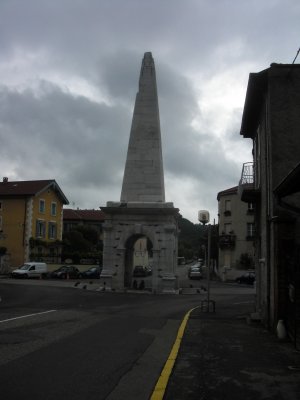
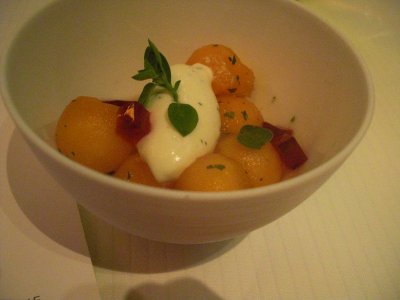 We also walked to dinner, which was at La Pyramide, so named because it's right next to the famous pyramid of Vienne, the one that used to mark the center of the Roman circus. The restaurant is an iconic one—the very first establishment ever granted three Michelin stars, back in the 1930s under chef Fernand Point (Bocuse finished his apprenticeship under Point). It's under a different chef now (who rejoices in the name Mark Henriroux—Mark Red-headed-Henry), of course, and not so highly rated but still excellent nonetheless, a GM 16/20. As you can see, the pyramid is right in the middle of the street (which is named for Fernand Point), and the bottoms of its four legs are actually a little below ground level. For scale, note that the two dark objects under it are seated teenage girls, chatting (with separate people) on cell phones.
We also walked to dinner, which was at La Pyramide, so named because it's right next to the famous pyramid of Vienne, the one that used to mark the center of the Roman circus. The restaurant is an iconic one—the very first establishment ever granted three Michelin stars, back in the 1930s under chef Fernand Point (Bocuse finished his apprenticeship under Point). It's under a different chef now (who rejoices in the name Mark Henriroux—Mark Red-headed-Henry), of course, and not so highly rated but still excellent nonetheless, a GM 16/20. As you can see, the pyramid is right in the middle of the street (which is named for Fernand Point), and the bottoms of its four legs are actually a little below ground level. For scale, note that the two dark objects under it are seated teenage girls, chatting (with separate people) on cell phones.
We ordered the "Springtime in the Valley of the Rhône" menu, so we ate all the same things. The table was set with a special container with four wells filled with four different colors of salt.
First amuse-bouche: A bowl of melon balls garnished with cubes of raspberry (or beetroot? I forget) jelly, a dollop of herbed fromage blanc, herb sprigs, and a sprinkling of very finely minced herbs.
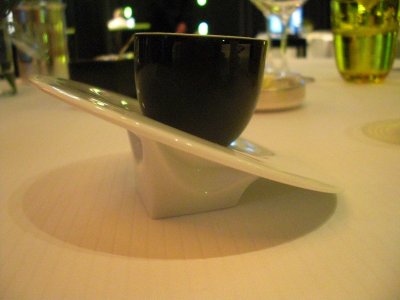
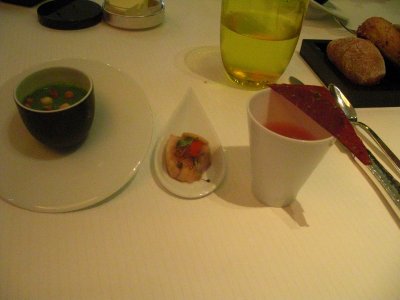 Second amuse-bouche, right to left: Watermelon gazpacho with tiny tapioca pearls in bottom, topped with a crisp slice of " grison," i.e. air-dried beef. A piece of barely cooked salmon garnished with a minute ginger shortbread cookie. A savory herb panna cotta topped with gelled cold watercress soup and tiny croutons.
Second amuse-bouche, right to left: Watermelon gazpacho with tiny tapioca pearls in bottom, topped with a crisp slice of " grison," i.e. air-dried beef. A piece of barely cooked salmon garnished with a minute ginger shortbread cookie. A savory herb panna cotta topped with gelled cold watercress soup and tiny croutons.
At the right, check out this side view of the bowl of panna cotta soup and its saucer! The arrangement looked pretty precarious to us until we realized that both the bowl and the saucer have beads of strongly magnetized metal embedded in them that let you lift the bowl out when you want to but hold it firmly in place when you set it back down, safe from any chance jostling.
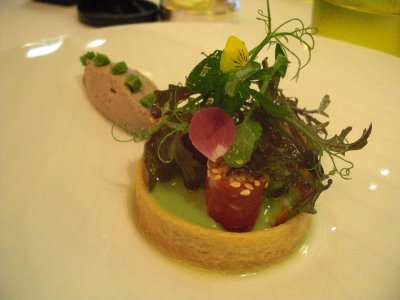
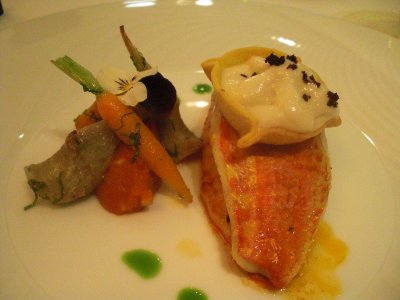 First course: A dish described as "like a tart of acidulated mousseron mushrooms" topped with chilled green pea soup and a tuft of colorful salad garnished with flowers and tasty pea tendrils. On the side, a quenelle of sesame foie gras mousse. The tart was delicious, and the foie gras outstanding. The little green cubes garnishing the foie gras were made of cooked, mashed, dried, and diced green pea! Crispy, flavorful, and delicious.
First course: A dish described as "like a tart of acidulated mousseron mushrooms" topped with chilled green pea soup and a tuft of colorful salad garnished with flowers and tasty pea tendrils. On the side, a quenelle of sesame foie gras mousse. The tart was delicious, and the foie gras outstanding. The little green cubes garnishing the foie gras were made of cooked, mashed, dried, and diced green pea! Crispy, flavorful, and delicious.
Second course: Filet of rouget (red mullet) topped with a little pastry tart filled with a saffron-flavored mousse of the fish's liver. On the side, a tomato compote flavored with sherry, a tiny carrot, and a cooked purple artichoke bottom.
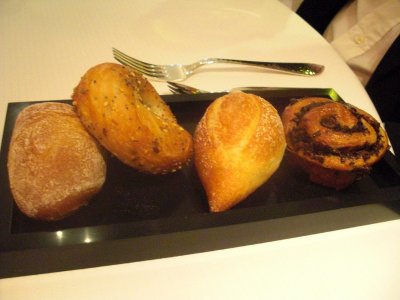
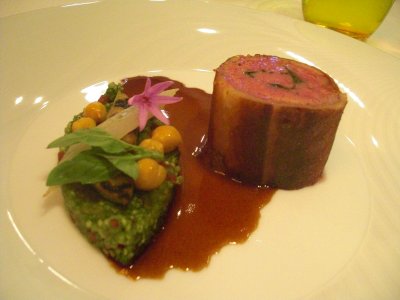 Bread: Here's the assortment of breads each of us was served. The one at the right that looks like a pecan twirl is actually rolled with chopped olives. My favorite was the miniature seven-grain bagel.
Bread: Here's the assortment of breads each of us was served. The one at the right that looks like a pecan twirl is actually rolled with chopped olives. My favorite was the miniature seven-grain bagel.
Third course: Saddle of lamb, boned and rolled with basil inside, then baked in a thin pastry crust. On the side was a boat-shaped cake of green quinoa, mashed chick peas, and preserved lemon, garnished with more basil, whole chickpeas, and a pink ornamental-onion flower. The lamb cooking juices were flavored with green anise. Yum.
Cheese: As usual, we each chose three cheeses from the trolley.
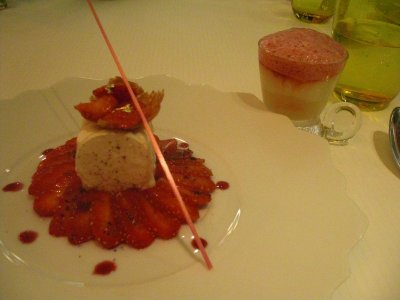
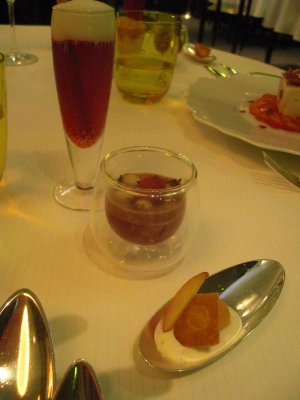 Dessert: Gariguette strawberries, raw and cooked, with cubeb pepper, a cylinder of mascarpone flavored with Bourbon vanilla, and a glass containing a small wine-cork-shaped cake topped with lemonello-spiked sorbet in turn topped with strawberry foam. Delicious!
Dessert: Gariguette strawberries, raw and cooked, with cubeb pepper, a cylinder of mascarpone flavored with Bourbon vanilla, and a glass containing a small wine-cork-shaped cake topped with lemonello-spiked sorbet in turn topped with strawberry foam. Delicious!
First mignardises: A red fruit soda, a tiny bowl of red-fruit custard, and a spoonful of mascarpone with a tiny cooky and two little slices of fruit on top.
Second mignardises: A square chocolate, a chocolate lollipop, and a triangle of red fruit paste.
The chef came out into the dining room at the end of the service, so we got to chat with him a little before walking home.
previous entry
List of Entries
next entry

 After breakfast, the first order of business was to go back to the Office de Tourisme for audioguides and do the city walking tour. With or without guides, though, the first thing you see in Vienne is the "Jazz à Vienne" poster. Here, on the left, is the full version, but myriad versions of it, showing all or only various parts of the image (in some, the creature grins toothily), are plastered on every available display surface and shop window not just in Vienne but all up and down the valleys of the Saône and Rhône as far as we traveled in any direction. I take the green creature to be a lizard of some kind, although it has an awful lot of legs for a reptile (as well as a sort of skirt of piano keys). The purple object must be the famous Vienne pyramid (photo of the real one below). Anyway, the Vienne Jazz Festival is a very, very big deal, and we got out of the area just in time—it was due to begin on 29 June and run for two weeks.
After breakfast, the first order of business was to go back to the Office de Tourisme for audioguides and do the city walking tour. With or without guides, though, the first thing you see in Vienne is the "Jazz à Vienne" poster. Here, on the left, is the full version, but myriad versions of it, showing all or only various parts of the image (in some, the creature grins toothily), are plastered on every available display surface and shop window not just in Vienne but all up and down the valleys of the Saône and Rhône as far as we traveled in any direction. I take the green creature to be a lizard of some kind, although it has an awful lot of legs for a reptile (as well as a sort of skirt of piano keys). The purple object must be the famous Vienne pyramid (photo of the real one below). Anyway, the Vienne Jazz Festival is a very, very big deal, and we got out of the area just in time—it was due to begin on 29 June and run for two weeks.
 One of the stops on the tour was the Salle du Patrimoine (the Hall of Patrimony), a free one-room museum dedicated to the urban development of Vienne from its founding (ca. 100 B.C.) to the present. It featured a lot of excellent models and maps illustrating the various stages of the city's expansion and, sometimes, contraction. On the left are two maps: the city in the 2nd century A.D. (left) and another of the same area between the 4th and 7th centuries (right), when it had gotten much smaller. The most amazing feature of the 2nd-century map is the city wall, which is the long sinuous black line surrounding the settled area on the east bank of the river. I had been puzzled to learn that the Roman forum (the largest black rectangle on the east bank) was built right down on the river, surrounded by four tall hills. That seemed very un-Roman—didn't they always settle on hilltops, for defensive purposes if nothing else? But that map of the city wall explained all. The river bank was convenient—those long black rectangles south of the city center were a major freight depot—but they couldn't risk an enemy's attacking from the higher ground, so they just ran the city wall out through what must have been open countryside at the time, in that odd, four-lobed pattern, to fence in all four hill-tops!
One of the stops on the tour was the Salle du Patrimoine (the Hall of Patrimony), a free one-room museum dedicated to the urban development of Vienne from its founding (ca. 100 B.C.) to the present. It featured a lot of excellent models and maps illustrating the various stages of the city's expansion and, sometimes, contraction. On the left are two maps: the city in the 2nd century A.D. (left) and another of the same area between the 4th and 7th centuries (right), when it had gotten much smaller. The most amazing feature of the 2nd-century map is the city wall, which is the long sinuous black line surrounding the settled area on the east bank of the river. I had been puzzled to learn that the Roman forum (the largest black rectangle on the east bank) was built right down on the river, surrounded by four tall hills. That seemed very un-Roman—didn't they always settle on hilltops, for defensive purposes if nothing else? But that map of the city wall explained all. The river bank was convenient—those long black rectangles south of the city center were a major freight depot—but they couldn't risk an enemy's attacking from the higher ground, so they just ran the city wall out through what must have been open countryside at the time, in that odd, four-lobed pattern, to fence in all four hill-tops!
 Some of the Roman buildings in Vienne are spectacularly well preserved. Perhaps the most striking is the "Temple d'Auguste et de Livie" (left) which was the focal point of the Roman forum and is now right in the middle of the town. I had to frame the photo very tightly to keep the café umbrellas out of the shot! It hasn't always been valued as it is today—at various times in its history, the spaces between its colums were bricked up so that it could serve as, e.g., a public library or office space.
Some of the Roman buildings in Vienne are spectacularly well preserved. Perhaps the most striking is the "Temple d'Auguste et de Livie" (left) which was the focal point of the Roman forum and is now right in the middle of the town. I had to frame the photo very tightly to keep the café umbrellas out of the shot! It hasn't always been valued as it is today—at various times in its history, the spaces between its colums were bricked up so that it could serve as, e.g., a public library or office space.
 Another major feature of Vienne is its Roman theater, which, unlike most we've seen, is still actually in use. We couldn't really see much of it because it was to be the major venue for the upcoming jazz festival, so it was heavily girded with construction fence, and a huge stage was being erected. Way up the hill above and behind it, though, we could see the Belvedere of the Pipet, crowned with a church (St. Marcel, maybe?) and a giant statue of the virgin Mary.
Another major feature of Vienne is its Roman theater, which, unlike most we've seen, is still actually in use. We couldn't really see much of it because it was to be the major venue for the upcoming jazz festival, so it was heavily girded with construction fence, and a huge stage was being erected. Way up the hill above and behind it, though, we could see the Belvedere of the Pipet, crowned with a church (St. Marcel, maybe?) and a giant statue of the virgin Mary.
 The very first restaurant we passed was the Tavern du Maître Kanter, an Alsatian themed chain that you encounter all over France. David had mentioned that he was hungry for a beef tartare, which they had, and I was seduced by the prospect of a flammekuche, which I love. Once inside, though, David postponed his beef, which is easy to come by in France, to go for a scallop-spinach-and-red-bell-pepper flammekuche, which you can't get just anywhere. I had the house flammekuche, with onions, lardons, cheese, and cream. Both were excellent, but I didn't think the scallops were really in keeping with the spirit of the dish.
The very first restaurant we passed was the Tavern du Maître Kanter, an Alsatian themed chain that you encounter all over France. David had mentioned that he was hungry for a beef tartare, which they had, and I was seduced by the prospect of a flammekuche, which I love. Once inside, though, David postponed his beef, which is easy to come by in France, to go for a scallop-spinach-and-red-bell-pepper flammekuche, which you can't get just anywhere. I had the house flammekuche, with onions, lardons, cheese, and cream. Both were excellent, but I didn't think the scallops were really in keeping with the spirit of the dish.
 One of the first things you see is this model of the Roman town, viewed here from the west looking east. The forum is the rectangle in the middle of the town, a few blocks inland from the far end of the bridge. The tiny rectangle inside it is the Temple d'Auguste et de Livie, the only part of it still standing. On the hillside behind and a little to the right of it, you can see the flat side of the Roman theater, and above that on the hilltop is the Belvedere of the Pipet, know occupied by a church. The Odeum is a little hard to see, but it's to the right of the theater and at right angles to it, on the adjacent hillside. You can see the city wall loop around the two hilltops to the left of downtown. The other end of it is the heavy, straight line running down to the river, many blocks south of the forum. The circus is out of the photo to the right. Just outside the wall, along the river south of town, are two long lines of warehouses, only part of the huge freight depot that was the town's reason for existence. The photo to the right is of a somewhat speculative cutaway model of those warehouses. Despite the glare on the plexiglas case, you can see, e.g., large wooden bins, bales, and stacked amphorae.
One of the first things you see is this model of the Roman town, viewed here from the west looking east. The forum is the rectangle in the middle of the town, a few blocks inland from the far end of the bridge. The tiny rectangle inside it is the Temple d'Auguste et de Livie, the only part of it still standing. On the hillside behind and a little to the right of it, you can see the flat side of the Roman theater, and above that on the hilltop is the Belvedere of the Pipet, know occupied by a church. The Odeum is a little hard to see, but it's to the right of the theater and at right angles to it, on the adjacent hillside. You can see the city wall loop around the two hilltops to the left of downtown. The other end of it is the heavy, straight line running down to the river, many blocks south of the forum. The circus is out of the photo to the right. Just outside the wall, along the river south of town, are two long lines of warehouses, only part of the huge freight depot that was the town's reason for existence. The photo to the right is of a somewhat speculative cutaway model of those warehouses. Despite the glare on the plexiglas case, you can see, e.g., large wooden bins, bales, and stacked amphorae. 
 Every Roman house (and Vienne considered itself a Roman city) was almost windowless on the outside. All the rooms faced inward onto one or more open courtyards—atria. Merchants regularly did business out of their houses—less valuable clients would be received in the entrance hall, more important ones "further in," and the most important in the atrium. The model on the left is of one of the largest houses in the neighborhood, already excavated. The atrium was typically planted as a garden, with a pool or fountain if the owner could afford it, and as the fragment at the right shows, the walls were painted with frescoes, usually also depicting nature. The most frequently preserved part of a Roman house is the mosaic floor; very few wall frescoes survive, and the Vienne site is particularly rich in them.
Every Roman house (and Vienne considered itself a Roman city) was almost windowless on the outside. All the rooms faced inward onto one or more open courtyards—atria. Merchants regularly did business out of their houses—less valuable clients would be received in the entrance hall, more important ones "further in," and the most important in the atrium. The model on the left is of one of the largest houses in the neighborhood, already excavated. The atrium was typically planted as a garden, with a pool or fountain if the owner could afford it, and as the fragment at the right shows, the walls were painted with frescoes, usually also depicting nature. The most frequently preserved part of a Roman house is the mosaic floor; very few wall frescoes survive, and the Vienne site is particularly rich in them.
 The museum displayed many mosaics, either wall-mounted like these or laid out on the floor, behind velvet ropes, where the curators have reconstructed whole rooms of a house (with furniture but without walls). All but one are in very typically Roman style of the period, whether figurative or geometric—they all looked very much like the ones we saw in Lyon. (A reconstructed dining room and bedroom were furnished with dining couches and beds copied from the one in Lyon—because they were made of wood and leather, only one intact one has ever been found—with turned wooden legs and leather webbing to support the cushions.)
The museum displayed many mosaics, either wall-mounted like these or laid out on the floor, behind velvet ropes, where the curators have reconstructed whole rooms of a house (with furniture but without walls). All but one are in very typically Roman style of the period, whether figurative or geometric—they all looked very much like the ones we saw in Lyon. (A reconstructed dining room and bedroom were furnished with dining couches and beds copied from the one in Lyon—because they were made of wood and leather, only one intact one has ever been found—with turned wooden legs and leather webbing to support the cushions.)
 The last item on the tour, in a special room all to itself, was this very large mosaic, of which only part is shown here. The figure in the center is some character from mythology who offended a powerful god and woke up to find himself being entwined and smothered by vines. Here he's shown trying to chop his way free. Some other figures appear nearer the edges, and at the right-hand edge you can see part of a blank square, where a particularly nice detail was removed at some time in the past. This mosaic was special in that it was in a strikingly different style from all other others, both in this museum and in the larger one in Lyon. Apparently, this style is usually found only in mosaics from Africa (where the Romans also had cities). The experts speculate that someone imported artists from Africa for the job—perhaps he had traveled and seen mosaics like this there.
The last item on the tour, in a special room all to itself, was this very large mosaic, of which only part is shown here. The figure in the center is some character from mythology who offended a powerful god and woke up to find himself being entwined and smothered by vines. Here he's shown trying to chop his way free. Some other figures appear nearer the edges, and at the right-hand edge you can see part of a blank square, where a particularly nice detail was removed at some time in the past. This mosaic was special in that it was in a strikingly different style from all other others, both in this museum and in the larger one in Lyon. Apparently, this style is usually found only in mosaics from Africa (where the Romans also had cities). The experts speculate that someone imported artists from Africa for the job—perhaps he had traveled and seen mosaics like this there.
 We also walked to dinner, which was at La Pyramide, so named because it's right next to the famous pyramid of Vienne, the one that used to mark the center of the Roman circus. The restaurant is an iconic one—the very first establishment ever granted three Michelin stars, back in the 1930s under chef Fernand Point (Bocuse finished his apprenticeship under Point). It's under a different chef now (who rejoices in the name Mark Henriroux—Mark Red-headed-Henry), of course, and not so highly rated but still excellent nonetheless, a GM 16/20. As you can see, the pyramid is right in the middle of the street (which is named for Fernand Point), and the bottoms of its four legs are actually a little below ground level. For scale, note that the two dark objects under it are seated teenage girls, chatting (with separate people) on cell phones.
We also walked to dinner, which was at La Pyramide, so named because it's right next to the famous pyramid of Vienne, the one that used to mark the center of the Roman circus. The restaurant is an iconic one—the very first establishment ever granted three Michelin stars, back in the 1930s under chef Fernand Point (Bocuse finished his apprenticeship under Point). It's under a different chef now (who rejoices in the name Mark Henriroux—Mark Red-headed-Henry), of course, and not so highly rated but still excellent nonetheless, a GM 16/20. As you can see, the pyramid is right in the middle of the street (which is named for Fernand Point), and the bottoms of its four legs are actually a little below ground level. For scale, note that the two dark objects under it are seated teenage girls, chatting (with separate people) on cell phones. 
 Second amuse-bouche, right to left: Watermelon gazpacho with tiny tapioca pearls in bottom, topped with a crisp slice of " grison," i.e. air-dried beef. A piece of barely cooked salmon garnished with a minute ginger shortbread cookie. A savory herb panna cotta topped with gelled cold watercress soup and tiny croutons.
Second amuse-bouche, right to left: Watermelon gazpacho with tiny tapioca pearls in bottom, topped with a crisp slice of " grison," i.e. air-dried beef. A piece of barely cooked salmon garnished with a minute ginger shortbread cookie. A savory herb panna cotta topped with gelled cold watercress soup and tiny croutons. 
 First course: A dish described as "like a tart of acidulated mousseron mushrooms" topped with chilled green pea soup and a tuft of colorful salad garnished with flowers and tasty pea tendrils. On the side, a quenelle of sesame foie gras mousse. The tart was delicious, and the foie gras outstanding. The little green cubes garnishing the foie gras were made of cooked, mashed, dried, and diced green pea! Crispy, flavorful, and delicious.
First course: A dish described as "like a tart of acidulated mousseron mushrooms" topped with chilled green pea soup and a tuft of colorful salad garnished with flowers and tasty pea tendrils. On the side, a quenelle of sesame foie gras mousse. The tart was delicious, and the foie gras outstanding. The little green cubes garnishing the foie gras were made of cooked, mashed, dried, and diced green pea! Crispy, flavorful, and delicious.
 Bread: Here's the assortment of breads each of us was served. The one at the right that looks like a pecan twirl is actually rolled with chopped olives. My favorite was the miniature seven-grain bagel.
Bread: Here's the assortment of breads each of us was served. The one at the right that looks like a pecan twirl is actually rolled with chopped olives. My favorite was the miniature seven-grain bagel.
 Dessert: Gariguette strawberries, raw and cooked, with cubeb pepper, a cylinder of mascarpone flavored with Bourbon vanilla, and a glass containing a small wine-cork-shaped cake topped with lemonello-spiked sorbet in turn topped with strawberry foam. Delicious!
Dessert: Gariguette strawberries, raw and cooked, with cubeb pepper, a cylinder of mascarpone flavored with Bourbon vanilla, and a glass containing a small wine-cork-shaped cake topped with lemonello-spiked sorbet in turn topped with strawberry foam. Delicious!